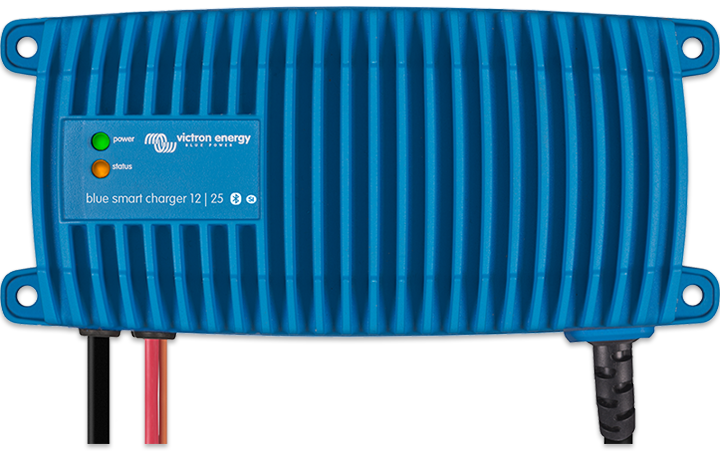I didn’t realize you were going to leave it at a pier with power….definitely get an onboard charger set up so you can plug in easy at the pier and at home.
I think I have read that link once before, but re read it just the same. That’s a lot of information there on the AGM’s. So how do I say this succinctly and quickly.…
AGM batteries can charge quicker by the nature of their construction, if you look at the manufacturers web sites, or contact interstate like I did a while back, AGM batteries can be charged at 25A’s as long as the voltage does not exceed 14.4 volts-very important is 14.4 volts. That is not mentioned at all in the lengthy thread. FLA batteries are usually in the 14.8 to 15V range and this can be witnessed by check battery voltage during charging on at least the Minnkota PC MK 220 & 330 chargers that I have, but FLA batteries can only be charged at 10-13% of their C20 rating, which is roughly 10A per 100Ah of battery.
The first post states that agm batteries can be charged faster than any chemistry, not true, LiFePO4 batteries can be charged without degradation at 50c, or 50 A on a 100Ah battery. This has a lot to do with resistance, the less resistance the less heat and the greater the charge rate in an AGM battery and this is due mainly to the surface area of the plates making for less resistance, unless I am mistaken, and that is why AGM batteries typically have a resting fully charged voltage of 12.9 volts.
Some great points there about smaller batteries, and the state of charge on said batteries in concert with our boats.. less than dramatic charge rates. By the way the output is far less than 25 A’s as contemplated by the OP in that other thread, its more like a total of 14A’s per engine or a 200 watt stator-I will be measuring this for our TR-1’s at the beginning of the season with the smart shunt I’m going to install for the house battery but will hook up both the start and house grounds to measure the full output and I am going to apply enough load until I see the voltage start to decay, and with the shunt on the batteries I can see current stop flowing into the batteries and start flowing out of the batteries in addition to both engines running at 3500 rpm which is peak out put, stay tuned for that. Having said that, it is a great point that a smaller lead acid battery will charge up faster than a larger one to approximately 80%, but what was not mentioned in that thread was the absorption phase of the smart charger with typically takes 8 hours to complete on both flooded and AGM batteries. While sulphation will be decreased, it is still going to occur unless the battery is fully charged. Again, the smaller battery will get charged up relatively quickly but our chargers will not charge these batteries enough to protect them from sulphating in a short period of time. Lest assume for a moment that a given house battery is discharged, mmmm say 35 Ah while out on the lake, and our boats chargers can put out, lets just say 12A’s total between the two at 3500 rpms-8 amps to run each engine and 6 left over for charging on each engine. Its going to take roughly 3 hours at that peak charging engine rpm to put back the 35 Ah’s of used capacity, at full charge, but, I’d need to see how our reg/rect’s handle charging lead acid batteries to see that. Typically with lead acid batteries the charge rate will start falling off due to the reg seeing the battery starting to get charged / resistance/ lower potential difference, and a fair amount of the charge will now start getting shunted to ground.. So yes, if one is not going to be able to put the batteries on a charger at the end of the day, regularly, the the smaller batteries make sense-except for LiFePO4 batteries which do not experience any degradation when left in a partial state of discharge.
So for the OP, his boat is going to have electricity to re charge the battery at the end of each day. It then depends on how he will use his boat and the amount of Ah’s in a day that he will use. A group 24 AGM will be a great choice if he is not going to be installing a big stereo, making margaritas with a 12V blender all day, floating at night with added lights and such. If he is going to listen to the stock stereo, perhaps blow some Barney towable’s for guests and charge a few cell phones the G24 AGM will be great, as long as it gets fully charged at the end of each day, with a proper charger, again, that depends on turnaround time as well, have to let the charger complete its cycle. That last bit is the problem I was running into with my boat, I’d get home at 2200hrs after all day on the lake and then wake up at 0400hrs and decide I wanted to go walleye fishing at another lake that day and my FLA batteries would not be charged using a 10A charger, they typically needed 12 hours to charge back up. I solved all of that by going to LiFePO4 batteries and 25 A chargers.
All good stuff! Thanks for linking that older thread, it was good to read all that info.

